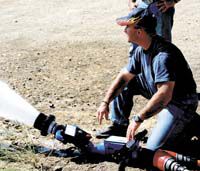| Members of the local underground coal mining brigade train on state-of-the-art equipment at Carbon County’s fire training facility. The volunteer firefighters worked with nozzles, foam appliances and mobile deck canons during the June 19 training session. On Tuesday, Bill Moser and Jeff Palmer of UtahAmerican Energy’s emergency preparedness division along with Damion Smith from the Wellington City Fire Department continued the process of training of personnel to man three local underground fire brigades during the session at the Carbon County Fairgrounds. |
On June 19, Bill Moser and Jeff Palmer of UtahAmerican Energy’s emergency preparedness division along with Damion Smith of the Wellington City Fire Department continued training of personnel for three local underground fire brigades at the Carbon County Fairgrounds.
“First and foremost I would like to say how much respect these men deserve,” said Moser. “These men put themselves in a dangerous position and go through a ton of training with no extra compensation to be a part of these fire brigades.”
The training Tuesday focused on state-of-the-art firefighting appliances including high powered portable deck guns, hand-held foam machines and improved hose nozzles.
The deck gun firefighters will start using the devices at Westridge, Tower and Crandall Canyon mines. It is capable of producing a stream of more than 300 gallons per minute.
“The equipment I am most excited about, however, is the foam production appliance,” commented Moser.
According to the the corporate manager, he purchased the equipment last August after observing the foam douse 40 foot flames in under a minute.
Wikipedia reported that water has been the universally accepted agent for suppressing fires. However, water is not the most effective agent in all cases.
For example, water is typically not effective on an oil fire. This is important within coal mines because of the high volume of diesel powered equipment.
In the late 1800s, a method of extinguishing flammable liquid fires by blanketing the flames with foam was introduced.
The original liquid was a mixture of two powders and water produced in a foam generator. The mixture was called chemical foam because of the chemical action used to create the material.
Chemical foam is a stable solution of small bubbles containing carbon dioxide with a lower density than oil and, therefore, will coat flat surfaces.
Because it is lighter than burning liquid, it flows freely over the burning liquid surface and extinguishes fire by a smothering action.
While chemical foam started this revolution in firefighting it has become obsolete today.
In the mid 1960s, the United States Navy developed a fire fighting foam called AFFF.
| Emergency preparedness manager Bill Moser of UtahAmerican Energy coal mining company instructs local fire brigade members on the proper technique associated with moving hose line as a team. According to Moser, all members of the underground brigade positioned in line behind the lead man push forward. The forward push relieves the leader of pressure and allows the brigade member to be accurate with the fire nozzle. |
AFFF is short for aqueous film forming foam. The material is synthetic foam with low viscosity that spreads rapidly across the surface of most hydrocarbon fuels.
A water film forms under the foam bubbles which cools the liquid fuel and will stop the formation of flammable vapors to provide a dramatic fire knockdown.
“The foam appliance is great because it can operate with very little water and with very little water pressure while still producing a large amount of foam,” explained Moser. “This equipment will be used primarily for fires the men could attack directly.”
Another major advancement in equipment for the fire brigade comes in the form of superior hose nozzles.
“These new nozzles will go a long way in providing the men will a sizable increase in both fog pattern size and straight stream range,” commented the emergency preparedness manager.
According to Smith of Wellington’s fire department and Rescue 5, the new nozzles are capable of producing six times the force of the current nozzle used underground.
“These nozzles can produce as much as 100-300 gallons per minute,” stated Smith.
For the men learning to use the state-of-the-art equipment is only the beginning of the training.
“These men will soon be training in over 1000 degree temperatures on a daily basis, they will learn to fight fire in the most dangerous circumstances available,” stated Moser.
The June 19 training was the second part in what will be a career long learning curve for the firefighters.
UtahAmerican started their fire brigade training as soon as Murray Energy Corporation acquired the local coal mines and has made an immediate and continuing commitment to the improvement of the local underground fire brigades according to Moser and Palmer.
“Our effort has been supported to a great degree here in Carbon County,” said site manager Palmer. “The county along with the Wellington Fire Department have contributed to our efforts from the beginning. It is obvious that Carbon County is an area that is sincerely committed to the safety of its coal miners.”

